Fast EV comparison test: Tesla Model 3 Performance, Polestar 2 Performance and Hyundai Ioniq 6 Epiq
EVs have picked up the baton from fast four-doors such as the Commodore SS and Falcon XR and we put some of the best to the test. Find out which one is best.
Electric cars have come a long way in a short time.
Initially viewed as boring science experiments, EVs have established a strong following for their cutting edge technology and stunning acceleration.
We’ve gathered three of the best performance-focused models under $100,000 and put them through their paces to see which delivers the biggest bang for the buck.

HYUNDAI IONIQ 6
The Ioniq 6 sedan won’t suit everyone’s tastes but the swoopy style makes it as slippery as possible to extend driving range.
The cabin is the roomiest of the bunch, with oodles of leg room front and back.
We tested the range-topping Epiq grade priced at about $96,800 drive-away. The Epiq AWD uses a 77.4kWh battery and two electric motors to make a healthy 298kW/605Nm of grunt, while providing up to 519km of range. This puts it last for both power and range in this company.
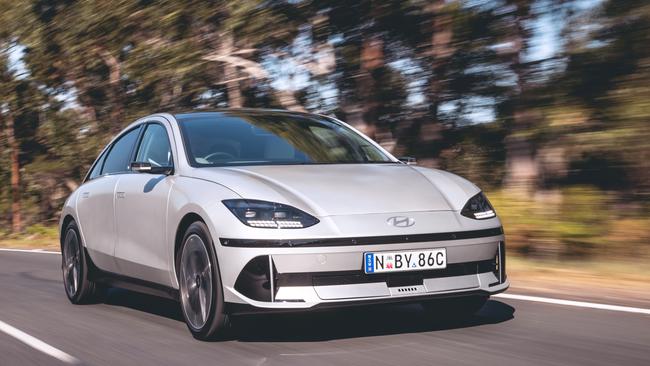
The car’s battery can be used to power household appliances and Hyundai even includes a regular household power socket in the back.
It’s the fastest charging of this trio, taking a claimed 18 minutes to charge from 10 per cent to 80 per cent.
Step inside and you are greeted by comfy leather-appointed seats, which are heated and ventilated in the front and heated in the rear. The cabin looks classy after dark, with ambient lighting that comes in 64 colours. There are twin 12.3-inch digital screens, one for the infotainment and the other for vehicle information. Apple CarPlay and Android Auto are included, as is satnav, digital radio, four USB-C ports and a wireless device charger.
The Ioniq 6 is brisk by normal standards but it lags in this company.
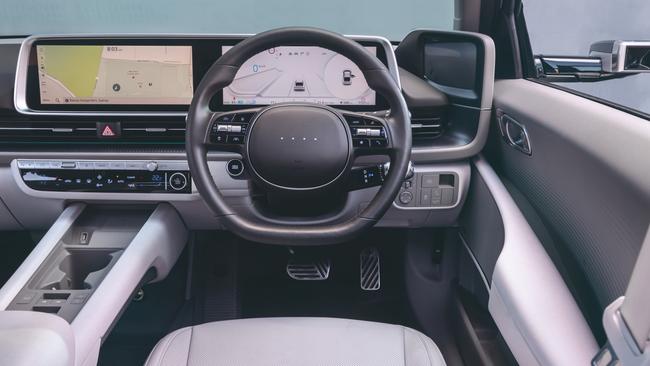
The suspension can feel jiggly and bouncy over poor quality roads, a symptom that afflicts many EVs.
Instead of normal side mirrors, it has two digital monitors that supply a digital feed from external cameras. It sounds impressive but in reality the screens are difficult to adjust to.
The steering feels a little too light and vague, dulling its sporty appeal, but our testers liked the fact that you could adjust the level of regenerative braking via paddle shifters. It’s the quietest of the bunch, keeping road noise at bay.
Hyundai guarantees its cars for five years/unlimited km, which matches the Polestar and trumps the Tesla’s four-year/80,000km warranty.
Servicing costs $1120 for four years.
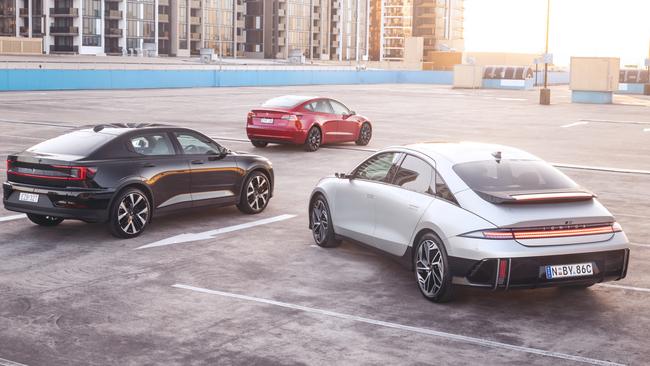
POLESTAR 2
Polestar has just updated the 2 and we tested the all-wheel drive dual-motor version with the Performance Pack added.
This increases power to 350kW and 740Nm, while its 82kWh lithium-ion battery provides a driving range of up to 568km. The Performance Pack also brings bigger brakes, updated suspension and better tyres.
It’s priced at about $92,500 drive-away and has standard features such as Nappa or vegan leather upholstery, heated front seats and a leather-wrapped steering wheel. It also comes with five years of free servicing.
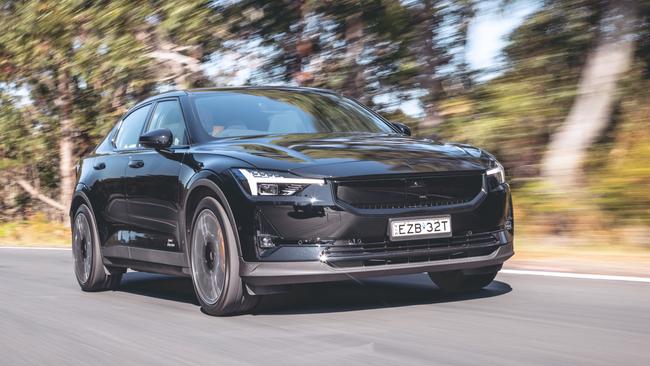
Our test car was also fitted with the $6000 plus pack that brings goodies such as a full panoramic roof, Harman Kardon stereo, heated steering wheel, heated rear window seats and ambient lighting. Without the optional extras it looks underdone next to the Hyundai but it does feel better built than the other three. It is the only one here that uses an older platform designed for petrol cars, which translates to the tightest cabin of the bunch in both rows.
The Polestar with the Performance Pack fitted is noticeably faster than the Ioniq 6, completing the sprint to 100km/h in 4.2 seconds, compared with 5.1 seconds for the Hyundai.
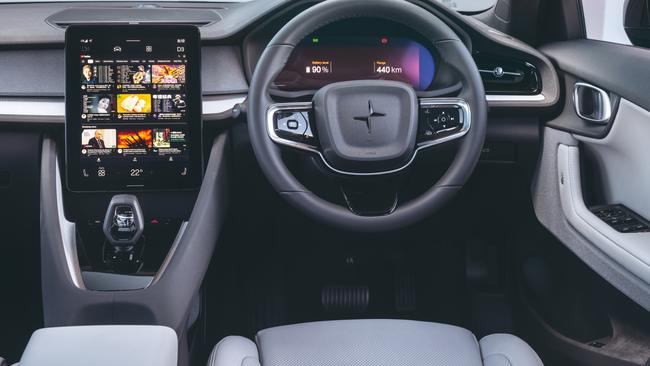
The rapid acceleration, firm suspension and meaty steering make it an excellent driver’s car.
Commuting around town is another matter, where it struggles to cushion occupants from road imperfections, occasionally crashing over sharper edged bumps.
The suspension is mechanically adjustable but the process is manual and requires skills beyond most motorists. The driver can adjust the brake regeneration settings and steering feel in the centre console.
TESLA MODEL 3 PERFORMANCE
Tesla threw us a curve ball after we’d completed this test, releasing an updated version of the Model 3. The changes aren’t earth-shattering but the range-topping Model 3 Performance we tested – which stops the clock at 3.3 seconds in the sprint to 100km/h – is no longer available. A new model is due next year but in the meantime, the updated Model 3 Long Range is an excellent alternative and costs just $75,000 drive-away.
It reaches 100km/h in 4.4 seconds and has longer legs with 629km range.
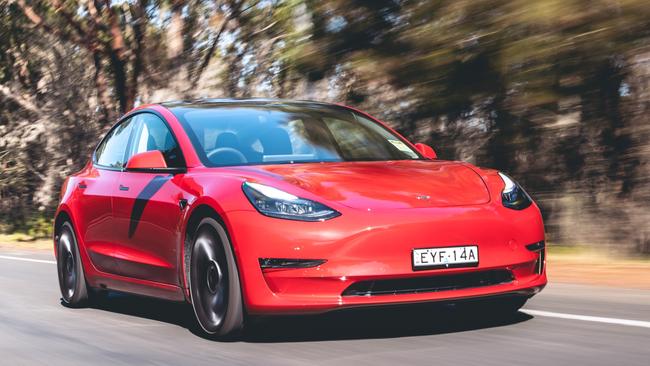
The performance model launches as hard as many supercars, the instant torque shoving you back into your seat. Having said that, anyone who buys the new long-range model is unlikely to be disappointed with its acceleration off the mark.
The Model 3’s low centre of gravity helps it sit flat through the corners and it deals decisively with bumps and mid-corner corrugations, although its steering can feel a little darty and unnerving on a tight, twisting road.
Around town, it is easier to live with than the Polestar, delivering a more comfortable ride over pockmarked suburban back streets.
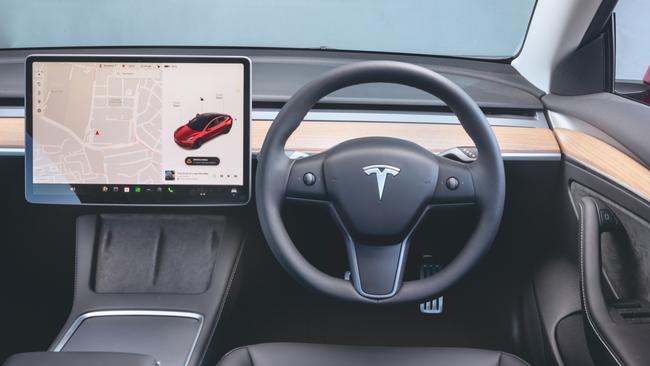
Things aren’t all rosy, though.
A sub-par four-year/80,000km warranty and no capped price servicing dilute its ownership credentials and the cabin looks austere compared to the others.
Some might enjoy the minimalist look but most would expect more glitz and glamour for the price.
All functions are controlled via the 15-inch central touchscreen, which can be fiddly and annoying to navigate on the move.
This is offset by some fun features that are available when the vehicle is stationary, including video games, Netflix and YouTube.

Unlike the other two here, there is no digital driver display.
The speedo is relegated to a small readout in the corner of the centre screen, which is not ideal.
The faux-leather upholstery and cabin finishes also feels less premium than the other two here but it’s appreciably cheaper and more practical, with a larger boot and front storage space.
It also wins points back for having the most comprehensive network of fast chargers, making it easier for owners to plan longer road trips.
VERDICT
The Hyundai has nifty features and plenty of gear but lacks the performance and panache you’d expect for the price.
The Polestar has a more up-market feel and is better to drive, but its harsh ride around town counts it out.
That leaves the Tesla. It’s the cheapest, fastest and easiest to recharge.
HYUNDAI IONIQ 6 EPIQ AWD
PRICE: $96,800 drive-away
MOTOR: Dual electric motors, 239kW and 605Nm
WARRANTY/SERVICING: Five years/unlimited km, $1120 for four years
SAFETY: Seven airbags, auto emergency braking, lane-keep assist, blind-spot detection, rear cross-traffic alert, driver fatigue warning, safe exit warning, rear occupant alert and 360-degree camera
RANGE: 519km
SPARE: Repair kit
LUGGAGE: 401L (rear), 14.5L (front)
TESLA MODEL 3 PERFORMANCE
PRICE: $89,700 drive-away
MOTOR: Two electric motors, 357kW and 659Nm (est)
WARRANTY/SERVICING: Four years/80,000km, no capped price program
SAFETY: Six airbags, auto emergency braking, lane-keep assist, blind-spot monitoring, rear cross-traffic alert, sentry mode, 360-degree camera
RANGE: 547km
SPARE: Repair kit
LUGGAGE: 561L (rear), 88L (front)
POLESTAR 2 DUAL MOTOR PERFORMANCE
PRICE: $92,500 drive-away
MOTOR: Two electric motors, 350kW and 740Nm
WARRANTY/SERVICING: Five years/unlimited km, free for five years
SAFETY: Eight airbags, auto emergency braking, lane-keep assist, blind-spot warning, rear cross-traffic alert, driver fatigue warning, 360-degree camera
RANGE: 568km
SPARE: Repair kit
LUGGAGE: 405L (rear), 41L (front)
Originally published as Fast EV comparison test: Tesla Model 3 Performance, Polestar 2 Performance and Hyundai Ioniq 6 Epiq


